Oxford Üniversitesi Göç ve İltica Araştırmaları Profesörü
Stephen Castles’ın R Yürükoğlu’nun 6. Ölüm Yıldönümü Münasebetiyle İTİB Tarafından Londra’da Marks Kütüphanesi’nde 1 Aralık 2007 tarihinde Düzenlenen Yürükoğlu Konferansı’nda Yaptığı Konuşmanın Tam Metnidir. Kaynak gösterilmek koşuluyla kullanılabilir.
Understanding the Political Economy of
the New Global Workforce
My aim in this lecture is to examine globalisation and the way it is bringing about social transformations in both developed and less-developed countries. This leads to a massive increase in international migration, and to major changes in its characteristics. Neo-liberal strategies are designed to produce a new mobile global workforce, stratified according to gender, ethnicity, race, skills, origins and legal status. As a result, old political models are being undermined, and new social movements are emerging. This poses new challenges for the left. New strategies and alliances are necessary.
Globalisation and imperialism
To understand the way the workforce is being restructured, we need to understand the process of globalisation – a difficult and controversial topic. Globalisation is often portrayed primarily as an economic process, to describe activities that used to be centred on national economies but have now spilled beyond their boundaries: In its most general sense ‘globalisation’ refers to the upsurge in direct investment and the liberalization and deregulation in cross-border flows of capital, technology and services, as well as the creation of a global production system – a new global economy (Petras and Veltmayer, 2000, 2).
The key actors in this new economic world are the multinational corporations (MNCs) – large companies that operate in many countries – and the global financial and commodity markets. A key aspect of the economics of globalisation is the role of global markets, but behind it all is the driving force of increasing profits to the big companies. There is an ideology behind globalisation that it will lead to a greater economic efficiency, and that in the long run it will reduce the differences between rich and poor countries, leading to an equilibrium in incomes between rich and poor countries.
But behind this economic project, which is portrayed in very positive terms, there is a political project which is conceived in normative or ideological terms. It is based on the neo-liberal model, the idea that the state should be as small as possible – it should really be only there to ensure public order, but not to regulate the economy. The economy should be de-regulated to give a free space for companies. Activities that used to be carried out by the state, for instance through nationalised industries, should be privatised, and that applies not only in developed countries but also in developing countries in the South.
The dominant neo-speaks “of opening up markets”, and refers to this as the “level playing field”, which means that the big international corporations should have freedom to act anywhere in the world. At the same time, there is an attack on the welfare state in developed countries, and also in the South. Educational systems, medical systems are being squeezed.
In fact this is a new form of imperialism. It is not really a new system as its supporters make out, it is really the latest stage of the development of the capitalist world economy, which started back in the fifteenth and sixteenth centuries with the European colonial expansion, and then went through various phases including the imperialist phase at the late nineteenth and early twentieth century. Now we are entering a new type of imperialism with new rules. But it has similarities with the old type of imperialism, for instance, the use of military force against anyone who stands in the way of the dominant countries and their business leaders. Only now we do not say we are “civilising primitive countries”, we say “we are acting against rogue states”, that is the new term.
There are news mechanisms of what is called “global governance”, in other words, the International Monetary Fund and the Wold Bank can impose neo-liberal principles though what they call “Structural Adjustment Policies.” The ideology that is meant to justify neo-liberal globalisation is that it is meant to lead to faster economic growth in poor countries, and in the long run therefore, to poverty reduction and a catch-up with the richer countries. Has that really happened?
Well, there is a lot of difference of opinion and conflicting data. One study by Alan Freeman, based on International Monetary Fund figures had the following findings.
In 1970 the “advanced countries” (IMF classification) received 68% of world income, the “rest of the world” got 32%.
By 2000 the “advanced countries” received 81% of world income, the “rest of the world” got 19%.
In the same period the world population share of the advanced countries fell from 20% to 16%.[1]
But it is not an even sort of split between North and South. Within the poorer countries of the South, there are areas of prosperity and elites, which are cooperating with the big corporations and which are very well rewarded, sometimes through corruption. You find very rich people in the South as well, and you also find in the North that the globalisation has led to economic restructuring, so we have areas of poverty within countries like Britain, Germany and so on.
One result is enormous wage differences between developed and less developed countries, and a recent study by the Global Commission on International Migration (sponsored by the UN); found that the per capita income in rich countries could be up to sixty six times as much as in poor countries. So for instance, by moving from say a country like Senegal, which is very poor, to a country like France, which is quite rich, you could increase your income up to sixty times, if you are lucky.
Drivers of migration
So what drives migration in this globalising economy? My theory is really that it is a process that works both ends of the migratory chain. Both in the poorer countries and the richer countries there are forces that interact to cause greater mobility.
In southern countries (by which I mean most of Africa, Asia and parts of Latin America) economic penetration by the big corporations and by global investment leads to a transformation of the economy. Agriculture is dramatically changed – some people call it the “green revolution” – productivity increases through use of mechanised equipment, new seeds, and new fertilisers. This sounds very good because it means more food is produced, but it actually means there is less work, and the land becomes concentrated in the hands of fewer and fewer big farmers. The poorer farmers and the landless farmers have actually been displaced from the land and have to move to the cities.
But the cities are not industrialising fast enough to provide jobs, so rural-urban migration means mass unemployment and very bad conditions in cities like Sao Paulo, Calcutta, Jakarta, Lagos, and so on. You have probably heard the talk about “global cities”, the idea of prosperous global cities like London, New York, Tokyo and Singapore. Let us always remember that Lagos, Sao Paulo, and Calcutta are global cities too, but not in such a nice way.
In these situations it is not only an issue of impoverishment, it is lack of human security. There is a big debate about the security in the North, but the insecurity in southern countries, say in Africa, is far worse. The governments are often undemocratic, there is little respect for human rights, conflict and violence are frequent, and the result is that many people become refugees and have to leave their countries.
So we have this coming together of economic conditions, political conditions, and social conditions that leads to impoverishment and bad living conditions. At the same time, the structural adjustment policies that I referred earlier are eroding the conditions of the middle classes because their jobs in the education and health sectors are often being removed by privatisation and reduction of state activities. So, all these factors lead to emigration in every form, as refugees, as low-skilled workers, and as high-skilled workers.
There are simultaneous changes in the North, in the more developed countries. Industrial restructuring means the decline of old industries like mining, steel and motor vehicles. People who were skilled workers in these industries have lost their jobs, their skills have become valueless, and their strong trade union organisations no longer exist. And at the same time, there is a decline in fertility, a lower birth rate in developed countries, which means the population, on average, are getting older.
Welfare states are being undermined by the same neo-liberal agendas as in the South. The young people who grow up in developed countries often have educational opportunities which mean that they will not do low-skilled work. There is a serious lack of workers for low-skilled activities. As all these things together drive the need for migration, and again it is both skilled people and less skilled people who are needed, because there is an underinvestment in the education systems of developed countries.
A second set of factors connected with globalisation are changes that actually makes it easier for people to be mobile. The new technologies make transport cheaper. It is easier to move several times, to move cyclically, to go back and forwards between two countries. It is easier to keep in touch with people at home through mobile phones and computers. There is a trend towards development of a global culture through electronic media, so local cultures which were quite intact and able to create intact life situations, are being gradually marginalised by these new forms.
In this situation we find that migrants begin to organise their own migration processes. You know this very well coming from Turkey: when the German government stopped Turkish immigration in 1973, or tried to stop it, it continued, because by then Turkish workers in Germany had their own networks and they brought in their family members and people from their communities. So, migrants began to organise their own movement; helping each other in finding jobs and housing, and so on.
We now talk about the emergence of trans-national communities. Instead of the pattern of the past that people migrated once in their lifetime and often moved for the whole of their life, now people move back and forwards, and maintain relationships in the country of origin, and the country they live, leading to long-term cross-border relationships. This can be seen as a pattern of globalisation from below, in other words, exactly those people who are not welcomed in the big economic model of the corporations and the governments have found their own ways at globalising in order to increase their life chances.
The politics of border control
The image that you often find in the mainstream media is a celebration of globalisation. An image of the freedom of flows across the world, and things being made where they can be produced most rationally, and going where they can be sold best; this applies to all sorts of commodities including dairy products, cars, mobile phones and so on.
But when you think of people, you get a very different image of globalisation. If you look at the high barbed wire fences around the frontier of the Spanish enclave of Melilla[*], which is an enclave within Morocco, you see another side of globalisation. In April 2006 a lot of African migrants and asylum seekers tried to cross this wall to get into Spanish territory. Several of them were killed, I think by the Moroccan police, and the next day the Spanish paramilitary forces were out to defend this wall. So this is how the North is defended from the South.
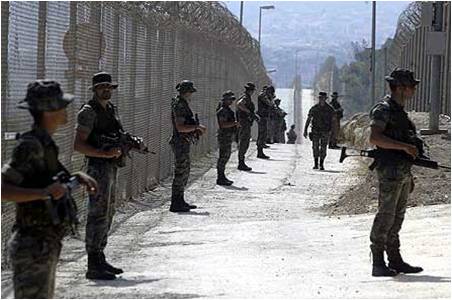
Let me give you a little bit more background on international migration. According to UN figures on migration from South to North (that is from less-developed countries (LDCs) to more developed countries (MDCs), in 2000 there were 175 million international migrants in the world. Today it is about 190 million. The majority of immigrants – about 110 million - are within the developed countries, and there has been rapid growth in numbers since 1990. But in less developed countries, there has been almost no change between 1990 and 2000. In other words migration is stagnating within the South, but migration to the North is increasing very rapidly. In fact, all the increase between 1990 and 2000 is due to migration from the South to the North. There is a very strong growth there for economic reasons.
The biggest form of international migration is from Southern countries, less developed countries, to more developed countries. There is quite a lot of migration between the countries of the North, and there is quite a lot of movement within the South, but quite little migration from the rich Northern countries to the poorer Southern ones. Obviously, this is a very crude division: you cannot really call the whole world either South or North. There are countries that are in between, transition countries like Russia, newly industrialising countries like Korea or Malaysia. These figures just give a very rough picture of where the issues lie.
But what is really quite important to realise is that only 3 percent of the world’s population actually are migrants. Ninety seven percent are not. So one sometimes is asked why this is such big political issue. Well, the reason is that migrant are concentrated in certain regions. So in more developed countries overall, 8.7 percent of the population are migrants, whereas in less developed countries it is only just over 1 percent. But in the most highly developed regions concentration is even greater, for instance, the United States has 35 million international migrants, 12 percent of the population; Western Europe 32 million, about 10 percent; Australia 4 million which is 23 percent.
There is a second, even higher, level of concentration in cities: every city in the rich part of the world has become multi-ethnic. In London, 25 percent of the population belongs to ethnic minorities; Toronto is said to be the most diverse city in the world at about 44 percent. Multiculturalism is really a way of life in developed countries now. That seems very frightening to some people. That is why migration has become such a big political issue.
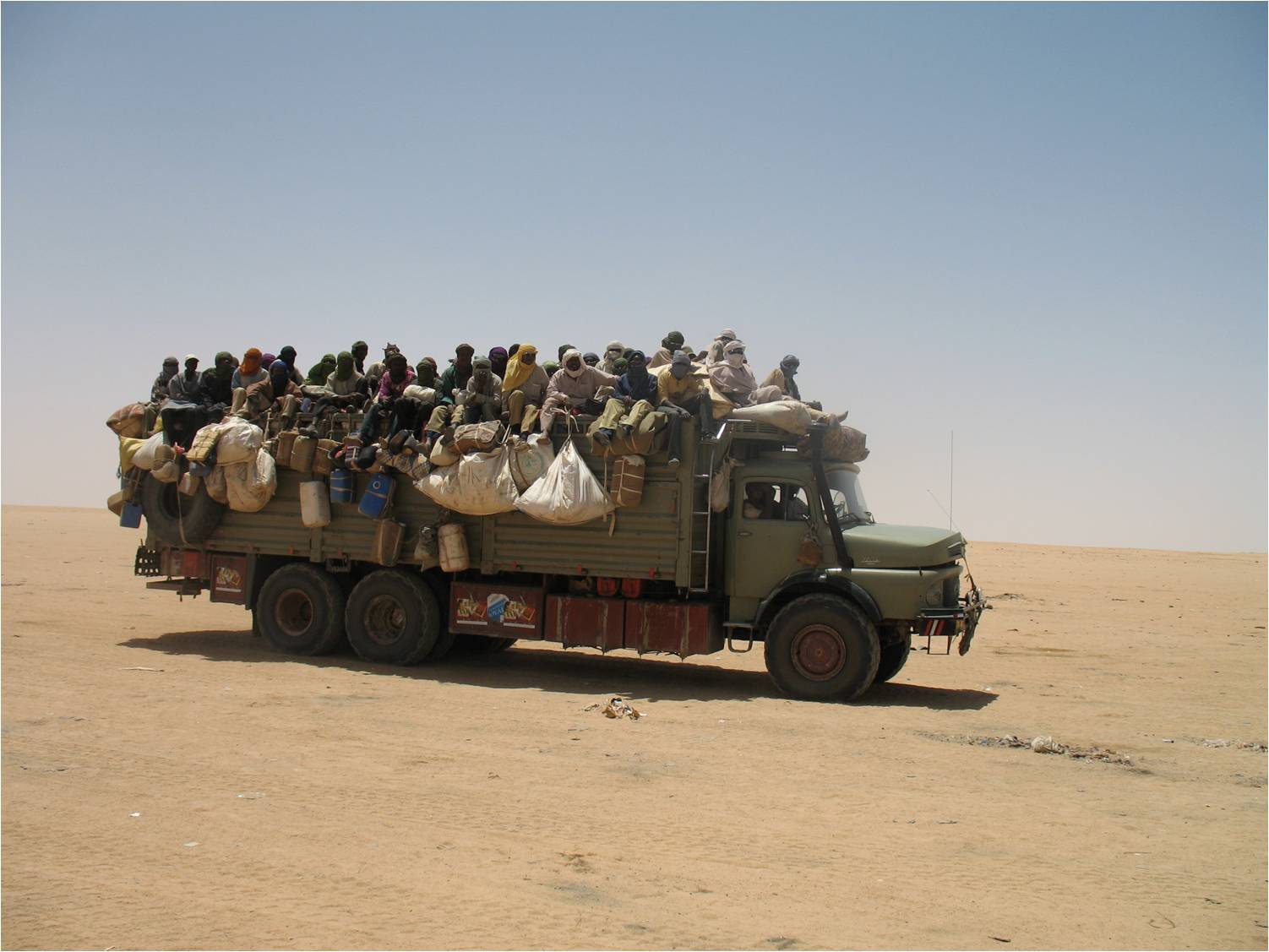
The media often disseminate images of Africans coming across the Sahara in large numbers, or arriving in boats on the southern shores of Europe. There seems to be a special fear of people coming from the sea. There seems to be a particular fear of people who come by boat – it must be based on historical stereotypes of invasion... It is a very unrealistic picture. The number of people, who come by boat to developed countries, is actually very small. It is a few thousand out of all the millions of migrant in the world. The overwhelming majority of migrants come by plane, and enters legally. They may work illegally, but they do not enter illegally.
So what does that mean for countries like Britain, which has a lot of immigration; or Germany; the European Union in general? These countries need workers, firstly for demographic reasons because their fertility is falling and the population is aging. They also need it because the economies of European countries, North America and Australia are going very well, leading to demand for labour. Developed countries want workers, but they see migration as a problem. The new minorities are seen as a threat to security, and the idea of diasporas, people living outside their country but still feeling that identity with their country of origin is seen as very threatening.
The solution is somehow to get workers, but not people. This is nothing new, because that was the idea of the guest worker systems of the 60s. States brought in workers, but they would not stay. It did not work, but this is what European governments are trying to do again.
This can lead to unexpected results. For instance a lot of people try to cross the sea to get from Africa to Spain. They used to come across the Mediterranean over the Straits of Gibraltar. Now, there is so much naval surveillance that it has become very difficult. So now people go all the way from Senegal or Mali up to the Canary Islands. In 2006 the European Union called a conference of about fifty European and African states, to try and work out a plan of action to stop this illegal migration. That was called the Rabat Plan of Action. There were two types of measures: The European Union would give money to African states to build up their police and naval forces, and to provide air surveillance. They would encourage African countries to act against on smugglers and traffickers. In return for that the African countries would get development assistance. They would get help in improving their higher education systems, and there some temporary migration would be permitted.
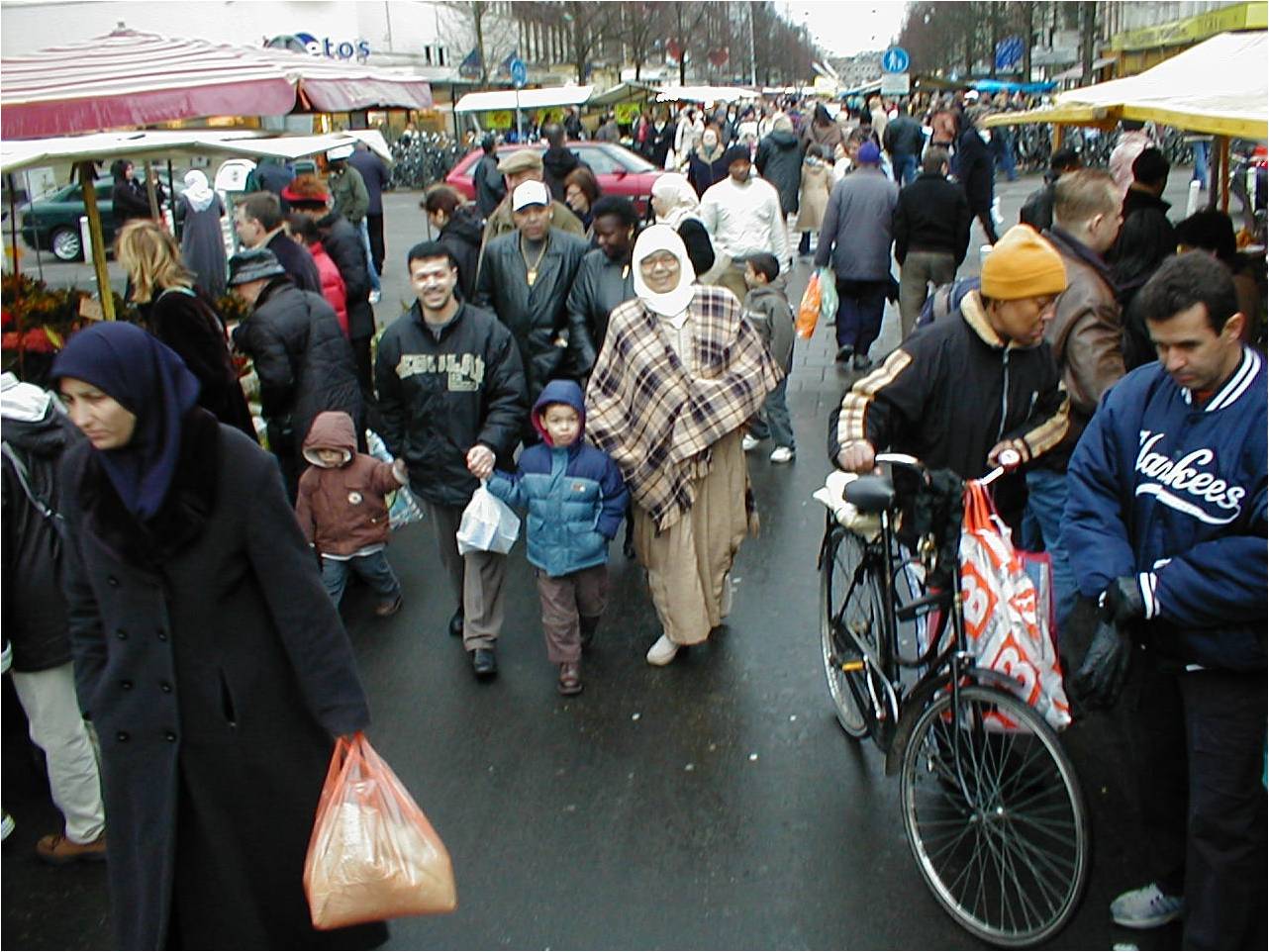
This is what the European Union is trying to do now. It tries to improve border control by getting African countries to cooperate. Promises of development assistance and a limited amount of legal labour migration are used to make the cooperation attractive to the African countries too.
It is very important today to have the right passport. As already mentioned, most migrants do not come across the see, they come by plane. Whether you can get in legally, and then get a permit to work depends on the colour of your passport, which country issues it, and so on. These images of walls are very striking, but it is the walls that you cannot see, biometrics, iris identification, fingerprints, electronic surveillance that really count today.
The figure of asylum seekers coming into Britain peaked at hundred thousand in 2002, and at that time, the Prime Minister Tony Blair said, “We will reduce asylum in Britain by fifty percent.” They achieved this. In fact the asylum stands about thirty thousand a year at the moment. So, by having very restrictive rules, it is now almost impossible to someone to come legally to Britain and to apply for asylum.
One way of stopping asylum seekers is by introducing visas, so, the border control is not at the border, it is in the country of origin. You have to go to the British Embassy or High Commission and get a visa. You do not get it of course, because they make it clear that they do not want you. And if you are a refugee, you cannot even go to the Embassy, because a policeman is standing in front, and it is too dangerous.

Another measure to stop asylum seekers and migrants is “carrier sanctions”, which means if an airline brings someone in without the right documents, they have to cover the costs, so the airline official becomes an immigration guard.
Then there is the system of “safe third countries”. For instance the British government has declared that Sri Lanka is a safe country: anyone coming from Sri Lanka will now not be allowed to stay here while making an asylum claim. They can make a claim, but they have to make it from Sri Lanka, and it is very unlikely that it will be accepted. Finally, there is the idea that once minorities are in a country they are a threat and they need be controlled to have special police forces, special agencies designed to control migrants.

A new global class structure?
It seems that a new global class structuring is emerging. One of its key features concerns the right to be mobile. Sociologist Zygmunt Bauman has written an interesting book about globalisation, in which he outlines this new global class structure. Its key principle, as he says is that “the riches are global, the misery is local.” You are supposed to stay where you are if you are poor, but if you can somehow get round it then you might have opportunities.
The new class structure distinguishes between different groups of people. If you have got education and training – “human capital”, as economists call it – you can move. The highly skilled are welcome. Asylum seekers and refugees are kept out. As for the less-skilled, there is a need for them, but governments are unwilling to recognise that for ideological reasons. So, there were some small programs to let people in like limited temporary worker schemes for agriculture and catering, or what is called “working holiday makers”. But millions of migrants can only work as illegals or irregulars, or undocumented workers. Many employers and governments actually prefer illegal workers because they are easier to control.
The country that does this most is the United States. The United States officially counts 12 million illegal residents. They actually count them because, for instance, as an illegal resident in some parts of the United States you can get a driving licence. This is very important, because in the United States public transport is so bad, that even illegal migrants have to be able to drive. Otherwise they cannot get to work. But if they are illegal, they cannot get a driving licence, and therefore they cannot get car insurance. So if they have an accident with a US citizen, there will be no compensation for that US citizen. So, they have introduced this scheme that you get a driving licence even if you are illegal. Spain does it too. Illegal workers in Spain can register with the municipal authorities. It has certain logic, but it does seem very strange
The new global workforce is not just migrants, It is important to see is how migrant labour force is integrated into the labour force as a whole, what their special role is. This is differentiated; some low skilled workers are treated in such a way that they can be better exploited, for instance, by being illegal. At the same time, there is privileged entry to the highly skilled,
Such issues affect the labour force as a whole. The whole thrust of neo-liberal policy has been to deregulate the labour market, to force workers into casual employment, so people who used have long term secure jobs with a career path are now classified as unskilled or semi-skilled, and are employed by the hour or by the day. They have no security, this applies particularly to young workers who entered the labour market and it is of course very hard to get workers who are employed in this way to join trade unions. So trade unions have become weaker and weaker.
This insecurity is a way of disciplining labour forces, and forcing down their wages. At the same time as welfare states are being squeezed, certain groups are excluded from welfare altogether, particularly the irregular migrants. That makes it easier to exploit and control them.
The result is a stratified global workforce with very mixed rights that is very hard to unite. This labour force is not only in one country, but goes across many countries. For instance, there was a strike recently in Poland in the Ford Motor Company. Ford could just increase the number of cars produced in Valencia and Bochum and send them to Poland. So it did not actually loose in production. With strong international unions it would be possible to stop that, and in fact, the German union was strong enough to realise what was happening and prevented it. But unfortunately the union in Spain was not. So that is the way the global capital can now divide and use the work force wherever it wants.
But it is not even just within the same company, because for instance Volkswagen in Germany can reduce social measures and increase working hours to workers, and simply say to the workers, ‘if you do not do it, no one will buy Volkswagens, they will buy Toyotas that were made under much worse conditions’. So this divide-and-rule strategy is very effective.
I just want to give you an example of how the welfare state crisis works in developed countries. In the Thatcher period we had a phase when British industry was almost demolished, especially traditional heavy industries with unionised steeled workforces. There was a period of deregulation, deindustrialisation and of deliberate attacks on the unions, for instance, the attack on the Miners’ Union. The result was incomes went up for some, down for others – what we call polarisation – so there is persistent poverty in many areas of Britain. Although Britain is a very rich country, it is also very unequal one.
When the Labour Party came in 1997, no basic change was made to that Thatcherite model. It was given a sort of new ideological gloss by speaking in terms of individual responsibility. People should not have rights to welfare. They should be responsible, and that meant working, and even if you were sick or disabled. Those who do not work are criminalised, and pushed into all sorts of control mechanisms: “workfare” is a way of forcing people to work. Those who do not work can be sanctioned with Anti-Social Behaviour Orders, or imprisoned under certain circumstances. Britain has now the largest number of prisoners of any European country excluding Russia. The rate of incarceration is second only to the United States among developed countries.
Similarly unemployment rates vary strongly by ethnic group in Britain, with far higher rates of unemployment for African- Caribbeans, Pakistanis and Bangladeshis than for white people. Unemployment is especially high for young people of non-European background. The same applies if you look at occupational data: there is an enormous ethnicisation of work opportunities. For instance, in Britain one in six Pakistani men is taxi driver compared with one in a hundred white British men. Forty percent of Bangladeshi men are either cooks or waiters compared with about one percent of British men. One in ten black African women is nurse compared with 3 percent of white English women.
So what does this mean? It means the working class is quite different from what it was twenty or thirty years ago. That has deep political implications. It is one reason why the old working class organisations, parties, and trade unions are struggling, because it becomes much harder to organise labour forces that are divided in these ways.
At the same time, new forms of political mobilisation are emerging. For instance in 2006 there was a movement of building workers in Dubai, one of the great expanding economic centres at the moment. The workers were working on the Burj Dubai, the world’s tallest building. The come from Pakistan, India, Bangladesh, China and Philippines. A skilled worker on this site, a carpenter, earns 4 pounds a day; an unskilled worker earns less then 2 pounds a day! Unions were forbidden in the United Arab Emirates until very recently. On 21st of March 2006 the workers got fed up with their low wages and poor working conditions and they rioted, damaging cars, offices, computers, and construction equipment. Then they went on strike. This had never happened in Dubai, and the government was forced to change its policies and to introduce labour rights. The workers at the new terminal at Dubai Airport also joined the strike.

In November 2007 there were riots in France, when two young people of African origin were killed after their motorcycle collided with a police car. Two years earlier, in November 2005, there were riots all over France. These were riots of young people of North African and Black African origin who were protesting against the fact that they are segregated in housing areas around the big cities where there are no employment prospects and quite bad conditions.
But these are not the sort of militant workers that we were used to seeing in the past. These demonstrators included women with headscarves, Muslim women demonstrating against police brutality in France. Today we experience with social actors who are very different from what we used to. These are the people at the moment who are forefront of militant action, that they are not the traditional working class organisations.
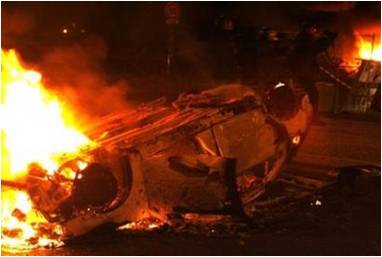
In 2006 there was a huge social movement in the United States, with protests over a period of about two months involving millions of people. Most of the people were Mexican or Latin American workers, some Chinese and Indian and other Asian, and they were protesting against a law that was being debated by the US Congress to introduce very severe penalties for illegal immigration. Remember, there are 12 million illegal migrants in the United States. The law that was proposed was actually stopped, but they did bring in a law which included building border fences all along the US border at a cost of billions of dollars. In some of these demonstrations there were lots of US flags. They were not anti-American – they were about getting included in the American society. But there were also protests on May Day and some of the protesters carried portraits of Che Guevara alongside American flags. There were socialist and left wing organisations in the protest, but also right wing and religious groups.
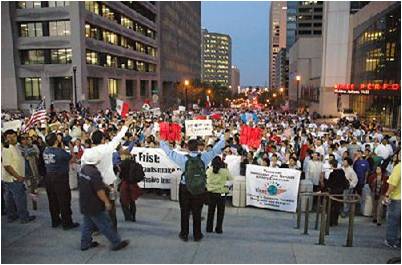
What does these all mean for the left? In the past, in France, the Communist Party took on a negative role towards migrant workers. In the 1970s there were examples of communist mayors sitting on bulldozers, and trying to demolish the hostels of migrant workers. That was so a prelude to the collapse of the French Communist Party. Many of the members of the French Communist Party actually went over to extreme right Front National, because they were nationalists and racists before they were communists – in some cases, of course not everyone.
Today’s movements are not, on the whole led by the left The trade unions are not quite sure what to do about these movements, whether to support them or not. And it is indeed very puzzling, because we see in these new social movements in some cases traditionalism, a strong role for religion, a strong role for cultural factors. We see even religious fundamentalism, and willingness to use violence. There is no overall political direction either at the national or the international level.
There all sorts of single issue movements like the environmental movement and the human rights movement. Many movements are concerned with local issues A lot of people involved in social movements do not really trust the left, because their experience of the past, such as the past situation in the Soviet block, and because communist leaderships have not always been supportive of such movements.
This is a challenge we really need to discuss, how should we relate to these movements? It is really a problem for me, and I am sure it is for you too. But I do want to emphasise that that anything we do about migration must not be in isolation, it must be part of an overall political strategy connected with opposition to neo-liberal globalisation.
It is not globalisation in itself that is bad, but the neo-liberal model of globalisation. For instance, one reason for migration is the impoverishment of African agriculture. To change that, we need to change the Common Agricultural Policy. If we dump European chickens at incredibly low prices in West Africa, we are destroying agriculture there. The World Trade Organisation allows the United States to subsidise its cotton farmers with billions of dollars, which is ruining the cotton industry of India. Neo-liberal structural adjustment policies are one of the main factors destroying education and health systems in poor countries. That needs to be addressed to.
In Britain we have a Department for International Development that is working to assist poor countries, and then we have a Department of Trade and Industry, providing export subsidies for weapons! We sell billions of dollars worth of weapons to poor countries contributing to wars, refugee flows, and economic ruin. There is a huge contradiction there.
Development policies need to be addressed in terms of improving human rights and dealing with corruption. It is important to get rid of elites that have actually benefited from the neo-liberal model, in order to achieve real change. Development strategies do need to look at issues of peace building and reducing forced migration. Our strategy should be to think about globalisation as a whole, as a system of inequality, and to work for fundamental change.
Transcript of the audio recording
[Corrections by SC 15 February 2008).
Stephen Castles
R. Yurukoglu Memorial Lecture
London 1 December 2007
[1] (Source: Alan Freeman “The Inequality of Nations” in Freeman, A and Kagarlitsky, B. The Politics of Empire, London, Pluto, 2004). See also: Milanovic, B. (2007) “Globalization and inequality” in Held, D. and Kaya, A. (eds.) Global Inequality: Patterns and Explanations Cambridge and Malden MA.: Polity).
[*] Melilla, (Mrich) a Spanish enclave in Moroccan territory; one of the disputed territories including Ceuta (Septe) port, and Perejil (Leyla) and Spanish “places of Sovereignty” such as Alboran Island, Chafarinas (Ceferin) islands, and other lesser islands off the Moroccan Coast of Mediterranean – Trans. Note.


